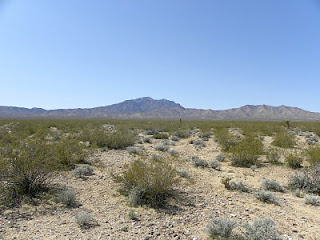The Bureau of Land Management (BLM) on Wednesday hosted a public meeting to discuss one of two solar projects that would be built in the Ivanpah Valley by First Solar Inc, drawing concerned citizens who expressed deep frustrations with a misguided renewable energy policy.
Desert experts and conservation advocates in attendance presented an alternative proposal to designate much of the valley as an Area of Critical Environmental Concern (ACEC) in order to protect a crucial genetic linkage for the threatened desert tortoise and habitat for rare plants and other wildlife. The full ACEC petition can be viewed at Basin and Range Watch's
website. Many citizens at the meeting have long called for distributed solar generation (such as rooftop solar), or placing solar facilities on lands that are already disturbed instead of on ecologically intact areas such as the Ivanpah Valley.
 |
| Ivanpah Valley, with the Clark Mountains in the background. |
The two projects proposed by First Solar--Stateline and Silver State South--would essentially shut off a wildlife corridor through the valley and decimate approximately 14 square miles of public wildlands. First Solar's plans would be in addition to projects that the BLM has already approved, including BrightSource Energy's Ivanpah Solar Electric Generating System (ISEGS), the Desert Xpress high speed rail, and the El Dorado transmission line.
In total, the projects would industrialize over 20 square miles in the Ivanpah Valley, which has been described by the Nature Conservancy as ecologically core and containing an above average richness of rare species.
According to the petition for an ACEC, the Ivanpah Valley has been identified as an area of excellent quality desert tortoise habitat with some of the highest tortoise population densities in the eastern Mojave Desert. The Ivanpah Valley is one of few places where the tortoise continues to thrive, despite the species' decline throughout most of its range. The valley provides a north-south corridor that is crucial for genetic diversity in the Mojave desert tortoise populations. If all of the proposed solar projects are built the connectivity will be lost, isolating and destroying a genetically significant population of tortoises.
The ACEC would preserve foraging habitat for Nelson bighorn sheep and golden eagles, and protect at least 36 special status plants have been identified in the Ivanpah Valley, including desert pincushion and white-margined penstemon. The petition had this to say about the area's significance for rare plants:
"Ivanpah Valley lies at the hub of a floristic frontier where botanists continue to discover new species to science, and it harbors high concentrations of rare plant species. Twelve rare plants species were documented on the approved Ivanpah Solar Electric Generating System project site."
 |
| The cave-dwelling evening primrose, a plant only recently discovered in the Ivanpah Valley, would be protected if the ACEC is accepted, and destroyed if First Solar's developments are approved. Photo by James M. Andre, copyright 2008. |
You can click on the images below for high resolution illustrations of the Ivanpah Valley, the boundary of the proposed ACEC, and the proposed layouts for destructive solar projects.
 |
| Click on the image to expand. This Google Earth image depicts the boundary of the proposed ACEC (in blue), and also shows the footprints of the most significant approved and proposed projects that could impact the viability of the ecosystem. |
 |
| Click on image to expand. This 3D Google Earth View of the Ivanpah Valley shows the footprints of the three major solar projects planned for the area, threatening to industrialize an entire valley of habitat designated by the Nature Conservancy as "ecologically core" to the Mojave Desert ecosystem. Projects in this image include the Desert Xpress rail, a major transmission line, the Ivanpah Solar Electric Generating System (ISEGS), Stateline solar, and Silver State solar. |






Comments
Post a Comment